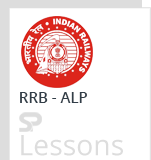Loco-Pilots/Driver is responsible to carry the train safely to its destination. Loco-Pilots/ Railway drivers playing a key role in Indian Railway's safe & punctual running of trains with security and productivity. Below listed are the RRB ALP Roles and Responsibilites.
 Skills
Skills
Railways’ drivers need to possess the following skills:
- Good mechanical knowledge.
- Good hands-eye co-ordination.
- The ability to concentrate for long periods of time.
- Physical stamina.
- Good memory.
- Flexibility.
- Excellent awareness of health and safety regulations and emergency procedures.
- A responsible attitude.
- Good judgment and decision-making skills.
- Reliability.
 Duties
Duties
The job of a Railway Driver demands hard work and great presence of mind along with courage to handle diverse conditions. For this one should have discipline, patience, responsibility, punctuality, commitment, courage and above all self-confidence. The job requires lots of hard work, stamina, alertness of mind, adaptability to follow difficult time schedules too. But the main and remarkable, highly appreciable role of Railway drivers is the only who works with full honesty, in day & night, in heavy cold, hot & Rainy weather.
Railways‟ Drivers / Loco-Pilots are the most important person in executing the huge task of transporting nearly 25 Million passengers and more than 2.8 Million Tons of freight daily with the help of 2,29,381 wagons, 59,713 coaches and more than 9,213 locomotive engines of various kinds. To transport 25 million passengers and millions of tons of freight and that too with taking care of both the traveler’s convenience and safety is not a mean task, the driver on whose sincerity the journey of a train depends.
The typical tasks undertaken by Railways’ drivers are:
i. Before starting the train/locomotive read safety circulars, safety bulletin, technical circulars, driver instruction, caution order, and divisional circulars.
ii. Before starting the train/locomotive read the caution order carefully in which sectional track work progress with temporary speed restriction is mention.
iii. Before starting the train/locomotive check the repair book of loco about any remark for any locomotive trouble.
iv. Before starting the train/locomotive check the oil level (diesel, lube oil, compressor oil in case of diesel locomotive and transformer oil, GR oil, compressor oil, exhauster oil in case of electric locomotive) and time to time during the run (One time during about 100 kilometers, it depends on drivers‟ mind).
v. After coupling with the train check brake pipe pressure continuity test with guard.
vi. After getting departure signal, loco pilot must start the train and run the train as per the aspect of station signals.
vii. Loco pilot must have sharp look out. While on run he must observe all permanent & temporary speed restrictions.
viii. Loco pilot must always ready to notice:-
- a. Any track defect through jerk or lurch,
b. Any unusual with self or others train. He must be mentally prepared for precautionary remedies as per the general & subsidiary rules and accident manual directives. It itself is sufficient to mental stress of loco pilots.





